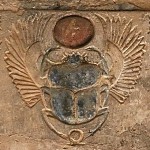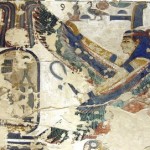Libyan Desert Glass and the Breast Ornament of Tutankhamen
One of the many fabulous items in the jewellery collection from the tomb of Tutankhamen is a breast ornament. A highly decorative piece in the form of a winged scarab, dating to around 1330 BCE, it is currently on display in the Egyptian Museum in Cairo (JE 61884; Burton Photo No. P1133; Carter No. 267d). Adorned with silver, semi-precious stones and glass paste, all set into gold, the eye-catching centrepiece is a semi-translucent green scarab. Remarkable for its beauty, the pectoral has the added interest of scientific and archaeological mysteries that have yet to be completely unraveled. [more…]
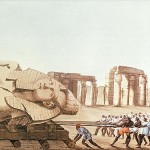
In Defense of Belzoni
The early explorers of Egypt, often associated with ideas of adventure, discovery and buried treasure, fascinate many people interested in the earliest days of Egyptology. No name elicits a stronger, and often negative reaction from scholars than that of Giovanni Belzoni, who explored Egypt in the early 1800s. Belzoni has often been depicted as a villain, an irresponsible treasure hunter who destroyed valuable antiquities as he blazed through Egypt in a search for gold. It is this image of Belzoni that forms many people’s preconceptions. [more…]
Book Review: The Lost Tombs of Saqqara
Consisting of eight chapters, the main attraction of The Lost Tombs of Saqqara is the exceptional beauty of the photographs. For those unfamiliar with the site, Saqqara is a vast, sprawling necropolis to the south of Cairo. It was used from the Early Dynastic period onwards for royal and elite burials, and is best known for the Step Pyramid of Djoser, Egypt’s earliest pyramid, and its other Old Kingdom pyramids and beautifully decorated mastaba tombs. This book takes the reader into the New Kingdom area of Saqqara. [more…]
AWT Conference 2011 – Excavating in the Valley of the Kings (Stephen Cross)
As described in the overview of the 2011 AWT Conference co-authored with Andrea Byrnes, the closing keynote lecture was delivered by Stephen Cross. His lecture created a buzz in the room and that has continued since Andrea Byrnes and I first posted about it on our respective blogs. In this account of his lecture, I shall present the theory as described by Cross: this is intended as reportage not as as detailed critique, although obviously a certain level of commentary is included. [more…]
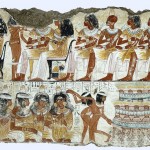
Egyptological Magazine – Edition 2
Welcome to the Second Edition of the Egyptological Magazine
In the Magazine we are pleased to see the return of two authors from the first edition. Brian Alm is continuing his popular series on the religion of the ancient Egyptians while Barbara O’Neill returns with another lavishly illustrated article. The image alongside, from the tomb of Nebamun is just one of the images in her article on the depiction of animal companions in tombs. We are delighted to welcome two new authors. Philip A. Femano has written a must-read article questioning the purpose of the blocking stones in the Ascending Passage of the Great Pyramid. Gary Beuk presents a biography of one of the best known early Egyptologists, and certainly the most colourful, Gionanni Battista Belzoni. Andrea Byrnes has added an article on the little known subject of Libyan Desert glass, a real treat for any Tutankhamun fans who have not heard of this unusual material found amongst his jewelery. We hope you will show your appreciation for all of our writers by leaving comments on their pieces. Our plan is for the Magazine to feature reviews as well as articles and you will find three of those as well, written by us. We attended the AWT conference last weekend and offer an overview and the first of our detailed reviews of invidual lectures. More will follow over the next few weeks. [more…]
Shabtis in Croatian Private Collections and Museums
Abstract
Approximately 5,000 Egyptian artefacts are housed in the more than twenty museum and known private collections in Croatia (4,042 in museums and circa 1,000 in private collections) dating from the 4th millennium BC to AD 641. There are 375 shabtis in nine museums and the known private collections in Croatia. Most (346) came from the Pharaonic periods of Ancient Egypt, but an additional 26 shabtis and 3 pseudoshabtis were unearthed during excavations in the territory of the Roman provinces of Dalmatia and Pannonia (today in Croatia). These shabtis were usually connected with the diffusion of the Egyptian cults during Graeco-Roman periods (c. 4th century BC to the 3rd century AD). The largest collection of shabtis is held in the Archaeological Museum in Zagreb (312). These shabtis were collected over a long period of time, from 1865 to today, and from various sources, but most are of unknown provenance. My analysis showed that all shabtis are genuine. They were crafted between the Middle Kingdom (AMZ, inv. no. E-310) and the 3rd c. AD. The following analysis of the shabtis showed that almost all known types and forms of shabtis can be found in Croatian collections. [more…]
The sAb in the Old Kingdom: a consideration of the title within the scope of a prosopographic study
Abstract
The article aims to give an overview of the activities of the bearer of the title sAb in the Old Kingdom and to propose a definition for it. It is based on the analysis of more than 500 documents, citing 76 titles including the term sAb and to collate all these in the titularies of the individuals concerned. It also attempts a brief description of the nature of the functions of the practitioners of justice, citing the autobiography of Weni. It further points up the connections to judicial institutions and the references to actions of a judicial nature, but also emphasises the “non-judicial” spheres involving the sAb. The article formulates a basic structure, centred round the knowledge and practice of law and orientated towards various sectors, such as the administration of the State in its diverse facets, the function of the judiciary and the management of patrimony in the great temples through specialisation. The term sAb could be the hallmark of the title holder in the field of law, but without confining him to the specific function of a sole judge. [more…]
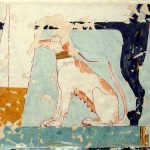
 By
By 